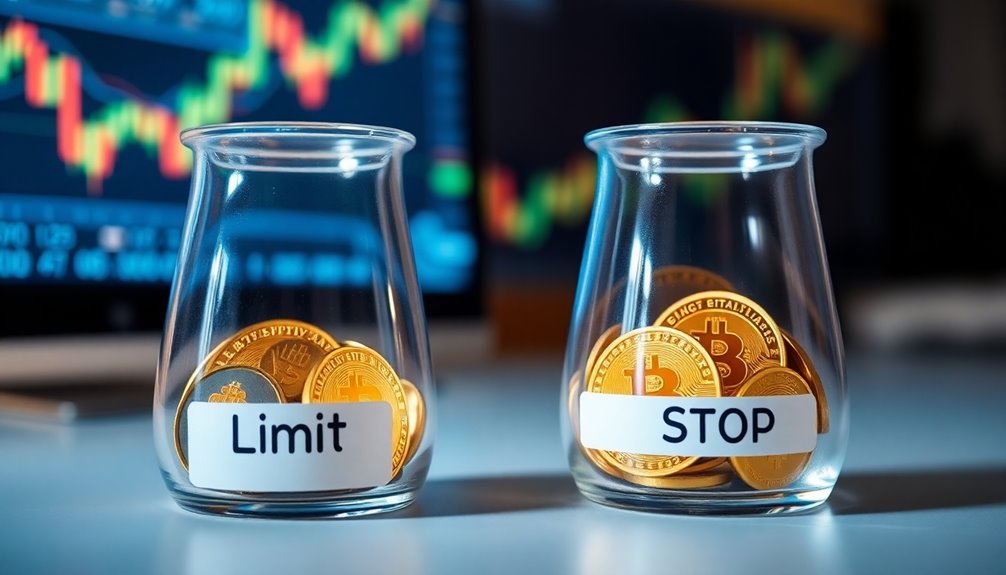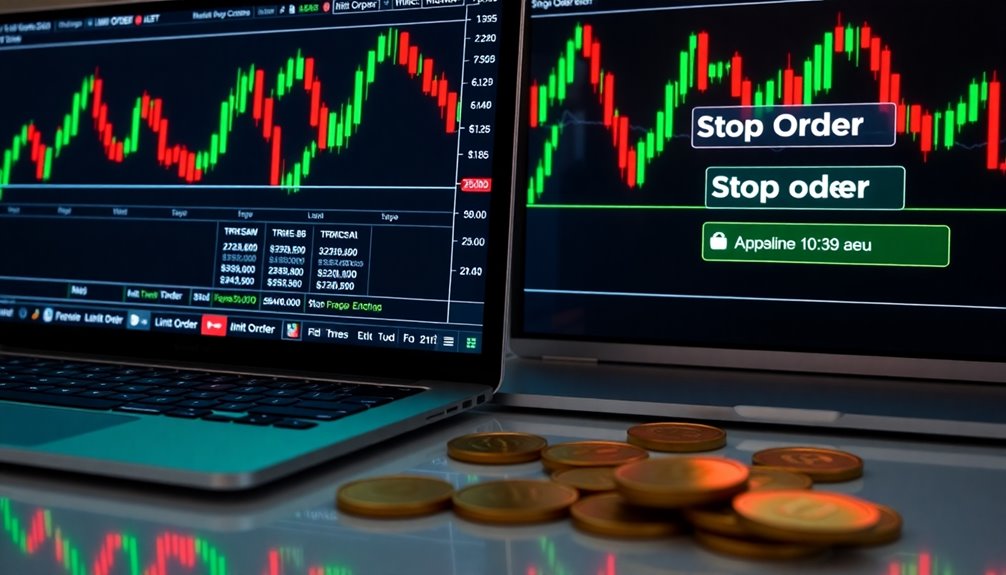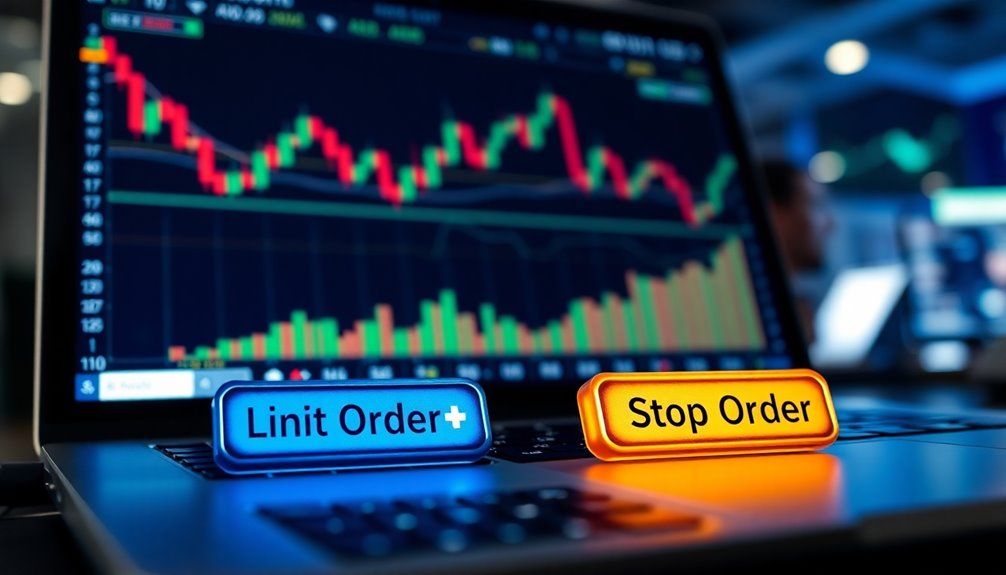When choosing between limit and stop orders, it depends on your trading goals. Use limit orders to set specific buy or sell prices, giving you control over execution and reducing the risk of unfavorable trades. They're great for targeting specific entry points. On the other hand, stop orders act as safety nets, automatically executing trades based on market movements. This can protect you during sudden price swings, although execution isn't guaranteed. By understanding these differences and tailoring your strategy, you can navigate the crypto market more effectively, and uncover more insights to refine your trading approach along the way.
Key Takeaways
- Limit orders execute at a specified price or better, ideal for precise entry and exit points in trading.
- Stop orders activate based on market conditions, offering a safety net against sudden price swings.
- Use limit orders to control purchase/sale prices and reduce slippage during transactions.
- Stop-limit orders combine features of both, allowing for execution at a specified price after a trigger is met.
- Choose limit orders for strategic buying/selling; opt for stop orders to manage risk in volatile markets.
Understanding Limit Orders

When you trade cryptocurrencies, understanding limit orders is crucial because they give you control over the price at which you buy or sell. A limit order allows you to purchase or sell a cryptocurrency at a specified price or better, ensuring that your trade only executes when the desired price is reached.
You can place a buy limit order to purchase at your limit price or lower, and a sell limit order to sell at your limit price or higher. This method reduces risk by preventing trades at unfavorable prices and can be set for various time frames. Additionally, using limit orders can help you manage your trades effectively by allowing you to avoid the risks associated with market orders that prioritize quick execution over price precision.
However, keep in mind that execution isn't guaranteed if the market doesn't reach your limit price, potentially leading to missed opportunities.
Understanding Stop Orders

Limit orders give you control over your trade prices, but stop orders add another layer of strategy to your trading approach.
With stop orders, you can set a trigger rate that activates either a stop market order for quick execution at the best available price or a stop limit order to secure a specific price. These tools help manage risk, automatically executing trades to limit losses based on market conditions. Additionally, stop orders provide control over buying and selling conditions, allowing traders to act swiftly when the market moves.
However, be aware of potential risks like slippage or execution price variance, especially in volatile markets.
Key Differences Between Orders

While both limit and stop orders play crucial roles in trading, understanding their key differences can significantly enhance your trading strategy.
A limit order executes at your specified price or better, giving you precise control over execution. In contrast, a stop order is triggered by a stop price and executed at the next available market price, lacking guaranteed execution at a specific price. This is important because a limit order guarantees execution at the desired price, while a stop limit order does not.
If you want a blend of both, a stop-limit order triggers at a stop price but converts to a limit order at a specified limit price.
Each order type serves different purposes; limit orders help secure favorable entry points, while stop orders manage risk by limiting potential losses.
When to Use Each Order

How can you decide between a limit order and a stop order for your trading strategy?
To make the right choice, consider your goals and market conditions. Use a limit order to target specific prices and manage risks effectively. It's great for accumulating assets at lower prices or locking in profits. Limit orders allow precise buying/selling price for crypto assets and can be adapted based on market insights. On the other hand, a stop order serves as a safety net, protecting against sudden market swings.
| Order Type | Best For | Key Benefit |
|---|---|---|
| Limit Order | Precise entry/exit points | Reduces slippage |
| Stop Order | Protecting against market drops | Automatic execution |
| Limit Order | Passive income opportunities | Enhances market liquidity |
| Stop Order | Quick market entry/exit | Risk management |
Making Informed Trading Decisions

Understanding the nuances of trading orders can significantly enhance your decision-making process in the volatile crypto market. Limit orders give you price control and guarantee execution at your specified price or better, ensuring you don't pay more than you want. They're great for entering or exiting trades at key levels. Interestingly, the cryptocurrency market peaked at approximately $3 trillion in November 2021, demonstrating the potential for significant price movements that limit orders can help capitalize on.
On the other hand, stop orders help manage risk by automatically executing trades when a specified price is hit, protecting your profits or minimizing losses. However, be aware that stop orders can fill at less favorable prices due to market gaps.
Frequently Asked Questions
Can I Cancel a Limit or Stop Order After Placing It?
Yes, you can cancel a limit or stop order after placing it, but only before it's filled or triggered.
Most crypto exchanges allow you to view and cancel your open orders easily. Just navigate to the trading interface, find your order, and select the cancel option.
Do Limit and Stop Orders Incur Trading Fees?
Yes, limit and stop orders can incur trading fees, but it depends on how they're executed.
Limit orders usually don't have fees unless they're filled as market orders. Stop orders also avoid fees until they're triggered.
When executed, taker fees apply. Keep in mind that different platforms have varying fee structures, so check your exchange's specifics to understand what fees you might incur while trading.
Saving on fees can significantly impact your overall trading costs!
Are There Any Restrictions on Order Sizes?
Think of order sizes as the gates of a grand castle—you can only enter if you meet certain requirements.
Yes, there are restrictions on order sizes across various platforms. For instance, Coinbase and Public generally have minimums higher than $1, while maximums can be around $100,000.
You'll find that total open orders can't exceed $200,000.
How Do I Set a Stop Price for My Stop Order?
To set a stop price for your stop order, navigate to the advanced trading section of your crypto exchange.
Choose between a buy or sell stop order, then enter your stop price—above the current market price for buys, or below it for sells.
Specify the quantity of cryptocurrency to trade, and confirm the order details to ensure everything’s correct. Once you have reviewed the order, proceed to finalize the transaction. If you wish to buy crypto with a credit card, make sure that your card is linked to your trading account and that it meets the necessary requirements for purchases. After confirming the payment method, you can submit your order and await the successful execution of your trade.
Regularly monitor the market and adjust your stop price as needed.
Can I Use Both Limit and Stop Orders Simultaneously?
You can definitely use both limit and stop orders simultaneously!
In fact, over 70% of active traders utilize a combination of these orders to manage their trades effectively.
By setting a stop-limit order, you can safeguard against losses while ensuring better execution prices.
This approach lets you automate your trading strategy, reducing the need for constant monitoring.
Just remember to carefully set your stop and limit prices for optimal results!
Conclusion
In the world of crypto trading, understanding limit and stop orders is like having a compass in uncharted waters. Each tool serves a unique purpose, helping you navigate price movements and protect your investments. By knowing when to use each order, you can make informed decisions that align with your trading strategy. So, whether you're aiming for precision or protection, mastering these orders will set you on the path to success in your trading journey.









